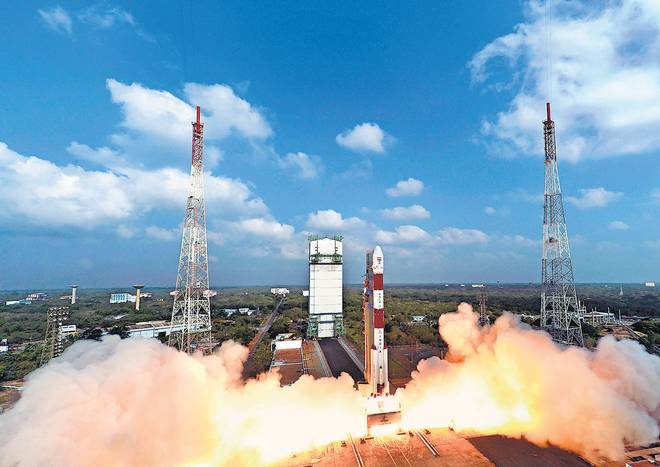
These include the country’s earth observation satellite Cartosat-2 series.
India, a one-rocket fledgling in space transportation compared to its European and U.S. counterparts, created launch history on Wednesday by placing a record 104 spacecraft in their desired orbits.
The feat was performed on the old reliable launch vehicle, the PSLV, numbered C-37, which took off from the first launch pad at the Satish Dhawan Space Centre, Sriharikota, at 9.28 a.m.
Precise launch
C-37 was a largely commercial flight as all but three passenger satellites, small nanosats, belonged to six other countries. The 29-minute launch went off precisely as planned; it took just 11 minutes from the release of the primary Cartosat-2 series spacecraft to the last launch of a client satellite, ISRO said after the mega-payload launch.
The PSLV, in the category of launch vehicles that can lift relatively light loads to space, now marks 38 successful missions in a row out of a total of 39 flights.
This time, it took to space a total of 1,378 kg, of which the primary satellite was 714 kg.
The latest Cartosat is the fifth in the series of six Cartosat-2 spacecraft, starting from Cartosat 2 in 2007 and followed by what were earlier marked A, B, C, D and E. The last one is due.
“After a flight of 16 minutes and 48 seconds, the satellites achieved a polar Sun synchronous orbit of 506 km inclined at an angle of 97.46 degrees to the equator — very close to the intended orbit. In the next 12 minutes, all 104 satellites successfully separated from the PSLV fourth stage in a predetermined sequence, beginning with the Cartosat-2 series, INS-1 and INS-2,” an official communique said.
ISRO’s workhorse lives up to its billing
The PSLV, which created launch history on Wednesday by placing a record 104 spacecraft in their desired orbits, has totally launched 46 Indian spacecraft, most of them Indian Remote Sensing (IRS) satellites.
As many as 180 small satellites of foreign customers contracted by ISRO’s commercial company Antrix Corporation have also reached space on this vehicle.
This time, it took to space a total of 1,378 kg, of which the primary satellite was 714 kg.
The latest Cartosat is the fifth in the series of six Cartosat-2 spacecraft, starting from Cartosat 2 in 2007 and followed by what were earlier marked A, B, C, D and E. The last one is due.
“After a flight of 16 minutes and 48 seconds, the satellites achieved a polar Sun synchronous orbit of 506 km inclined at an angle of 97.46 degrees to the equator — very close to the intended orbit. In the next 12 minutes, all 104 satellites successfully separated from the PSLV fourth stage in a predetermined sequence, beginning with the Cartosat-2 series, INS-1 and INS-2,” an official communique said.
The PSLV, 39 flights old since 1993, also launched the Indian Moon mission Chandrayaan-1 in 2008; and is set to launch a private lunar mission for Bengaluru start-up Team Indus in late December this year.
“It is confirmed that all 104 satellites have been successfully deployed in the orbit,” PTI quoted PSLV Project Director B. Jayakumar at the Vikram Sarabhai Space Centre (VSSC) as saying.
“After separation, the two solar arrays of Cartosat-2 series satellite were deployed automatically and ISRO Telemetry, Tracking and Command Network (ISTRAC) at Bengaluru took over the control of the satellite,” the space agency said.
In the coming days, the satellite will be brought to its final operational configuration.
source: http://www.thehindu.com / The Hindu / Home> News> National / by Special Correpondent / Bengaluru – February 15th, 2017